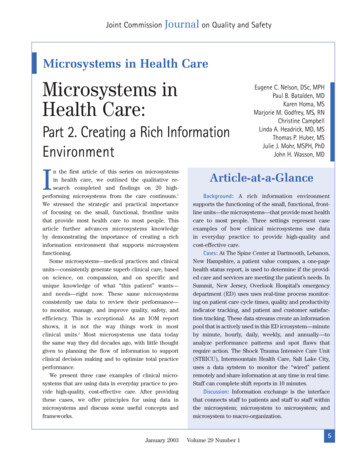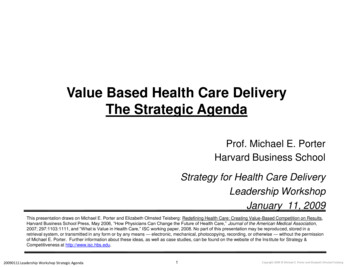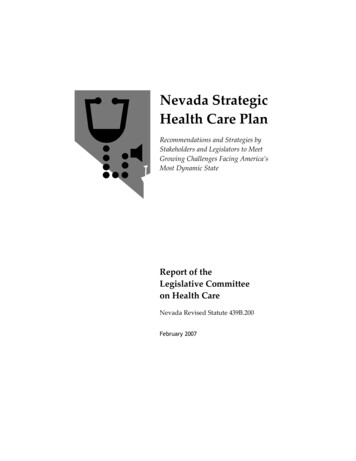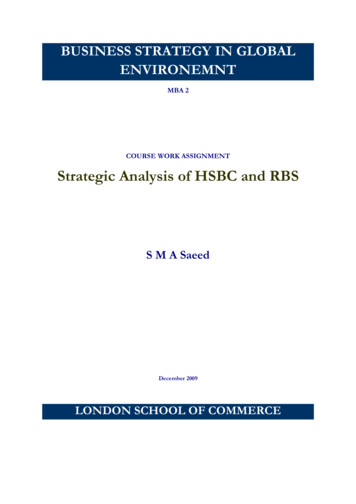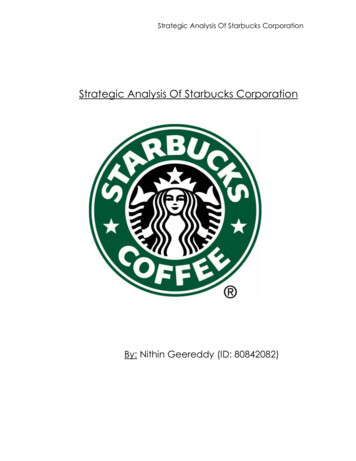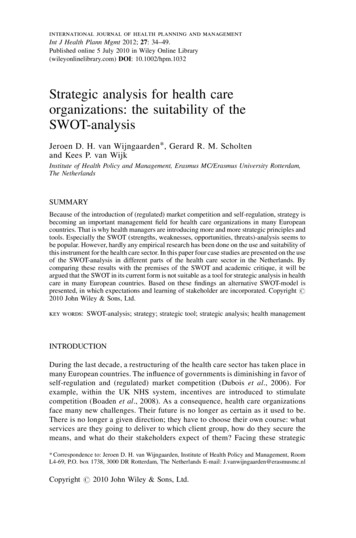
Transcription
international journal of health planning and managementInt J Health Plann Mgmt 2012; 27: 34–49.Published online 5 July 2010 in Wiley Online Library(wileyonlinelibrary.com) DOI: 10.1002/hpm.1032Strategic analysis for health careorganizations: the suitability of theSWOT-analysisJeroen D. H. van Wijngaarden*, Gerard R. M. Scholtenand Kees P. van WijkInstitute of Health Policy and Management, Erasmus MC/Erasmus University Rotterdam,The NetherlandsSUMMARYBecause of the introduction of (regulated) market competition and self-regulation, strategy isbecoming an important management field for health care organizations in many Europeancountries. That is why health managers are introducing more and more strategic principles andtools. Especially the SWOT (strengths, weaknesses, opportunities, threats)-analysis seems tobe popular. However, hardly any empirical research has been done on the use and suitability ofthis instrument for the health care sector. In this paper four case studies are presented on the useof the SWOT-analysis in different parts of the health care sector in the Netherlands. Bycomparing these results with the premises of the SWOT and academic critique, it will beargued that the SWOT in its current form is not suitable as a tool for strategic analysis in healthcare in many European countries. Based on these findings an alternative SWOT-model ispresented, in which expectations and learning of stakeholder are incorporated. Copyright #2010 John Wiley & Sons, Ltd.key words: SWOT-analysis; strategy; strategic tool; strategic analysis; health managementINTRODUCTIONDuring the last decade, a restructuring of the health care sector has taken place inmany European countries. The influence of governments is diminishing in favor ofself-regulation and (regulated) market competition (Dubois et al., 2006). Forexample, within the UK NHS system, incentives are introduced to stimulatecompetition (Boaden et al., 2008). As a consequence, health care organizationsface many new challenges. Their future is no longer as certain as it used to be.There is no longer a given direction; they have to choose their own course: whatservices are they going to deliver to which client group, how do they secure themeans, and what do their stakeholders expect of them? Facing these strategic* Correspondence to: Jeroen D. H. van Wijngaarden, Institute of Health Policy and Management, RoomL4-69, P.O. box 1738, 3000 DR Rotterdam, The Netherlands E-mail: J.vanwijngaarden@erasmusmc.nlCopyright # 2010 John Wiley & Sons, Ltd.
SUITABILITY OF THE SWOT-ANALYSIS35questions, managers in health care are introducing strategic tools and methods,which were developed for the private sector, to help them provide the answers(Kramer, 2001). It is unclear whether these methods and tools can and should beused in the health care sector.For decades, strategy and strategic management has been an importantmanagement field in the private sector (Grandy and Mills, 2004). There aremany journals and management books in which strategy is seen as the key tosuccessful entrepreneurship (for example Swayne et al., 2006; Finley 2000;Johnson and Scholes, 1999; Cummings et al., 2003; Stacey, 1996; Grant, 2005;Jauch and Glueck, 1988). Only recently has strategic management caught theattention of managers in the public sector. This development is strongly influencedby advocates of what is called ‘‘New public management’’. It is a strong plea tointroduce principles and methods from the private sector in the public sector, asthey are supposed to boost performance (Desmidt and Heene, 2005; Boaden et al.,2008). This view is supported by authors who assume a generic managementapproach, which states that there are principles relevant for all organizations(Weber 1947; Fayol, 1916), and by those who think the differences between thepublic and the private sector have disappeared (Boyne and Dahya, 2002; Rainey,1997). Adversaries can be found among authors who believe that the public sectordoes have unique characteristics which set it apart from the private sector (Nuttand Backoff, 1993). Although there are no final conclusions, managementprinciples and methods from the private sector are used by public managers moreand more.Illustrative for this development is the growing popularity of the SWOT (strengths,weaknesses, opportunities, threats)-analysis in the health care sector (Kramer, 2001).The SWOT-analysis is a tool developed for strategic analysis. It consists of aconfrontation between external developments and internal capabilities. Externaldevelopments are identified as either opportunities or threats for the organization;internal capabilities are described as strong or weak points of the organization. Basedon the confrontation between the two, strategic options or even a new strategic coursecan be identified for the organization (Johnson and Scholes, 1999). In a study, amonghealth managers in 38 home care organizations, 51 hospitals, and 112 nursing homesin the Netherlands more than 80% reported to use the SWOT-analysis as part of theirstrategic process (Kramer, 2001). Despite its popularity, little is known about theactual use and effectiveness of the SWOT-analysis. Hence the central question of thisarticle; is a SWOT-analysis suitable as a tool for strategic analysis in the health caresector?To answer this question, first of all the premises on which the SWOT-analysisis based will be identified, together with the methods that can be used to performa SWOT-analysis. In fact, it will be shown there is no real clarity abouthow to perform a SWOT-analysis. Also criticism regarding the SWOT will bedescribed.In spite of the popularity of the SWOT-analysis, we were not able to find asingle scientific publication on the actual use of the SWOT-analysis in thehealth care sector. There are a number of publications about the possible use of aSWOT-analysis in the public sector (Swayne et al., 2006; Noordegraaf, 2004;Copyright # 2010 John Wiley & Sons, Ltd.Int J Health Plann Mgmt 2012; 27: 34–49.DOI: 10.1002/hpm
36J. D. H. VAN WIJNGAARDEN ET AL.Mouwen, 2004), but also no empirical studies on the actual use. That is whyfor this article four case studies were undertaken in different parts of thehealth care sector on the use of the SWOT-analysis. In the discussion the findingsabout the assumptions, the methods, and the criticism regarding the SWOTanalysis will be confronted with the results from the case studies to answer thecentral question.METHODSThis is an explorative study on the use of the SWOT-analysis in the health care sector.It is a follow-up of an inventory study done at this institute in 2001 on the use ofstrategic tools in health care organizations in the Netherlands (Kramer, 2001).Although the first study showed that the SWOT-analysis was frequently used, it wasnot clear how the SWOT-analysis was used. That is why four qualitative case studieswere undertaken in different health care sub-sectors in the Netherlands: hospital care,care for the mentally ill, care for the handicapped, and care for the elderly. In eachsub-sector, a single organization has been selected that, according to the opinion oftheir secretary of the board of directors, uses the SWOT-analysis as a strategic tool.The organizations have been identified using the personal network of the researchers,so access would be easily granted.Different research methods were used. First, all relevant documents on strategicmanagement in these organizations were collected and analyzed. Then, key figuresinvolved in the strategic analyses from different parts of the organization wereselected by using a snowball method, starting with the secretary of the board ofdirectors. In total 26 respondents were interviewed, each for 1 h, using a halfstructured questionnaire. Topics were: the use of the SWOT-analysis in theorganization; the methods used for both the internal and the external analyses; theinvolvement of the respondent; the results of the SWOT-analysis; and the effects onthe strategic course of the organization. All interviews were recorded andtranscribed. The interviews were analyzed using partly open codes and party codesbased on the literature on SWOT-analysis. Data were collected by four juniorresearchers under supervision of three senior researchers. The quality of the study isensured by means of peer-review within the research group, member checks, bypresenting the results to the respondents and triangulation of several data-sources.At the start of this study relevant literature has been studied, both the most popularstrategic management books (Swayne et al., 2006; Finley 2000; Johnson andScholes, 1999; Cummings et al., 2003; Stacey, 1996; Grant, 2005; Jauch and Glueck,1988) and articles on strategic management and the SWOT-analysis (for example:Dubois et al., 2006; Grandy and Mills 2004). Relevant literature has been identifiedby using the databases: PUBMed and online content. Also all tables of content of allthe issues of the last five years of four important scientific journals on managementwere searched for relevant papers: Strategic Management Journal, Academy ofManagement Journal, Journal of Management Studies, and British Journal onManagement.Copyright # 2010 John Wiley & Sons, Ltd.Int J Health Plann Mgmt 2012; 27: 34–49.DOI: 10.1002/hpm
37SUITABILITY OF THE SWOT-ANALYSISFINDINGS FROM THE LITERATURE ON THE SWOT-ANALYSISPremises and critiqueThe SWOT-analysis can be seen as a typical product of the so-called design school ofstrategic management (Mintzberg and Quinn, 1992). Central to this design school isa normative approach to management. Management should be as rational as possibleand tools and methods are developed to support this. Selznick, Andrews, andChandler are seen as important representatives of this school of thought. Fourpremises are characteristic of this school: strategy is leading, organizations areautonomous, organizations have clear demarcations, and an organization is a rationalhierarchy. Critics of this school disagree with most of these premises.Strategy is leading. In the ‘‘design school’’, strategy enjoys high prestige.Strategy has been associated with the apex of the organization. In the hierarchy,decision-making strategy is at the top, tactics and operations follow. Also, strategyrefers to the long term which is seen as more important than the short term. Thesuperior prestige of strategy becomes manifest in Chandler’s famous quote:‘‘Structure follows strategy’’: strategy first, the other elements of organizingsecond (Chandler, 1962).Critics question the high prestige of strategy. The critique comes down to theopinion that strategy in their view is only defined as very important, but in reality hasno superior influence on organizational outcomes (Grandy and Mills, 2004). Othermanagement fields, like HRM, seem to be of equal importance for performance(Boxall and Purcell, 2003; Paauwe, 2004). Strategy is, therefore, not superior butinterdependent with other management areas. Also, strategy is not an exclusive taskfor top executives anymore. Strategy is a quite common phenomenon at all levels oforganizational decision making; for example, heads of departments are often askedto develop strategic plans in close interaction with their personnel.Organizations are autonomous. The design school sees organizations as autonomous entities. Of course, there are limitations, but organizations are expected to carryout their own strategic analyses, formulate strategic options that are suitable to them,choose the best option, and run the implementation process, all on their own(Andrews, 1971).Critics stress the interdependence of organizations. Modern authors seeorganizations as part of a network. Organizations only survive by continuouslymonitoring the interactions in the network. Different authors even claim that manyorganizations are networks themselves, namely loosely coupled systems ofinterdependent units (Klijn and Koppenjan, 1999). In this perspective, organizationsare managed by contracts and information and not much by power (Bruijn andHeuvelhof, 1999). An identical critique can be found in the popular perspective ofstakeholder management. In this perspective stakeholders play a central part indefining the strategy and goals of the organization; therefore interdependence is thenorm, not autonomy (Johnson and Scholes, 1999).Copyright # 2010 John Wiley & Sons, Ltd.Int J Health Plann Mgmt 2012; 27: 34–49.DOI: 10.1002/hpm
38J. D. H. VAN WIJNGAARDEN ET AL.Organizations have clear demarcations. In the classical perspective of the designschool on organizations, there is a clear demarcation between internal andexternal factors. This makes it possible to analyze internal and external factorsseparately and to confront the results (Andrews 1971; Quinn 1988). According to thedesign school, this confrontation is a central part of strategic analysis.Many authors denounce the separation between the external and the internalfactors (Denis et al., 2007). The critique even goes back to Katz and Kahn(1966) who developed the concept of the organization as an ‘‘open system’’.Authors with a network perspective argue that capabilities and means are oftenshared in a network (Klijn and Koppenjan, 1999), which makes it difficult tosee a clear demarcation between organizations. Other authors state thatorganizations are very much dependent on stakeholders, who are not alwayslegally part of the organization (Johnson and Scholes, 1999). For example, inmany Dutch hospitals medical specialists are not employed by the hospital, theywork as independent contractors. Are they part of the organization or of theenvironment?The organization as rational hierarchy. The design school stresses the importanceof rationality in hierarchical decision making. Managers should control thestrategy process and ensure its rationality by using tools and procedures (Quinn,1988). CEOs should be able to choose the best options for their organizationamong the alternatives, based on a thorough analysis (Johnson and Scholes,1999).Critics point to the limitations of rational decision making in organizations. Oftennot all the relevant information is available; rational decision making can also be verytime consuming and is often not even possible because it is too complex: there are toomany intervening variables. In practice not only rationality but also vision andintuition are, therefore, very important in strategic management (Wissema 1996;Barry and Elmes, 1997). Strategic management is in their view also a ‘‘socialprocess’’ in which several stakeholders with different interests participate. Strategycan be thought of as an activity that takes place in an arena or, as some say, in agarbage can (Krogt and Vroom, 1988). Furthermore, strategic management is anongoing process; it emerges and there are no final decisions (Hendry, 2000). That iswhy these critics point out that a ‘‘bureaucratic’’ use of instruments of strategicanalysis should be avoided.Because of these four premises, Mintzberg and Quinn (1992) state that themachine bureaucracy is the archetype which the design school uses for organizations.They think many strategic tools that originate from this school cannot and should notbe used in the health care sector, because most health organization are professionalbureaucracies not machine bureaucracies.Procedures for the SWOT-analysisThe SWOT-analysis is mostly described as a set of rules used to confront internalmeans and capabilities with external developments. Central question is: do we haveCopyright # 2010 John Wiley & Sons, Ltd.Int J Health Plann Mgmt 2012; 27: 34–49.DOI: 10.1002/hpm
SUITABILITY OF THE SWOT-ANALYSIS39the means and capabilities to withstand threats and exploit opportunities in ourenvironment? In its most basic form it involves the following steps:(1)(2)(3)(4)Formulate external developments as opportunities or threats;Formulate internal means and capabilities as strengths or weaknesses;Confront strengths and weaknesses with opportunities and threats;Use the results to formulate strategic options (Mandour et al., 2005; Kramer,2001).It is only on these most basic steps that there seems to be any consensus. There isfar less clarity and consensus on the concrete procedures. The popular strategicmanagement books (Swayne et al., 2006; Finley, 2000; Johnson and Scholes, 1999;Cummings et al., 2003; Stacey, 1996; Grant, 2005; Jauch and Glueck, 1988) and alsoarticles on the SWOT-analysis (for example Pickton and Wright, 1998; Novicevicet al., 2004) present very different procedures. Still, two kinds of approaches can beidentified: the regulated SWOT and the organic SWOT.The regulated SWOTDifferent authors think that the SWOT-analysis should be more than listing somerelevant external and internal factors. The SWOT-analysis is seen as the final step ofthe strategic analysis. Other strategic tools should be used to identify the relevantexternal and internal factors; preferably based on sound quantitative data. Also rulesshould be developed to ensure a more rigorous SWOT (Nijssen and Lighart, 1999;Finlay, 2000; Pickton and wright, 1998; Ambrosini et al., 1998; Kotler, 2000). Forexample, Johnson and Scholes (1999) introduce a confrontation matrix. In thismatrix strong and weak points of the organization are confronted with externalthreats and opportunities. Scores are attributed so it can be determined which strongpoints, weak points, opportunities, and threats should be targeted with the newstrategy. Finlay (2000) suggests comparing internal capabilities and means with thecapabilities and means of the competition. Only by comparing can be judged whichmeans and capacities are strong or weak points.The organic SWOTOther authors are less enthusiastic about a regulated SWOT. They fear a bureaucraticuse of the instrument with no attention paid to the fact that different parties areinvolved with different interests, that vision and intuition are important informulating strategy, and that there are limitations to rational thought in humans(Wissema, 1996; Barry and Elmes, 1997). These authors prefer a more organicSWOT-analysis, with ‘‘open’’ rules that can be adjusted to the organizationalcontext. Grant (2005) even prefers not to distinguish between strengths, weaknesses,opportunities, and threats, but only to confront external with internal factors. Hethinks these factors are impossible to typify, because many are both a strength or aweakness, an opportunity or a threat, depending on your point of view.Copyright # 2010 John Wiley & Sons, Ltd.Int J Health Plann Mgmt 2012; 27: 34–49.DOI: 10.1002/hpm
40J. D. H. VAN WIJNGAARDEN ET AL.FOUR CASE STUDIESIn Tables 1a–d (Appendix 1) our findings on the way the SWOT-analysis is usedin each case are presented. In spite of the differences in sub-sector and area inwhich they operate, the similarities between the cases are striking. In all cases theTable 1a. The use of the SWOT in a general hospitalCharacteristicsStrategic tools usedCoordinating theSWOT-analysisInternal analysisExternal analysisConfrontationRemarksGeneral hospital located in a city of average size 530beds (average size) little competitionEFQM-model, PEST-analysis, SWOT-analysisAn editorial committee consisting of the secretary of theboard of directors, the quality manager, and a staffemployee supporting the medical staff.As part of an accreditation process an internal analysisneeded to be performed using the EFQM-model. Theanalysis was done in different meetings with the editorialcommittee, unit managers, the head of planning andcontrol, and a representative of the medical staff.Results were discussed during an internal conferencein which all hospital employees could participate.Only during this conference findings were discussed interms of strong and weak points.The external analysis was done during a discussionmeeting in both the board of directors and the board ofthe medical staff. The categories of the PEST-analysiswere used as an organize
Jul 05, 2010 · selected by using a snowball method, starting with the secretary of the board of directors. In total 26 respondents were interviewed, each for 1h, using a half-structured questionnaire. Topics were: the use of the SWOT-analysis in the . ensured by means of peer-rev
